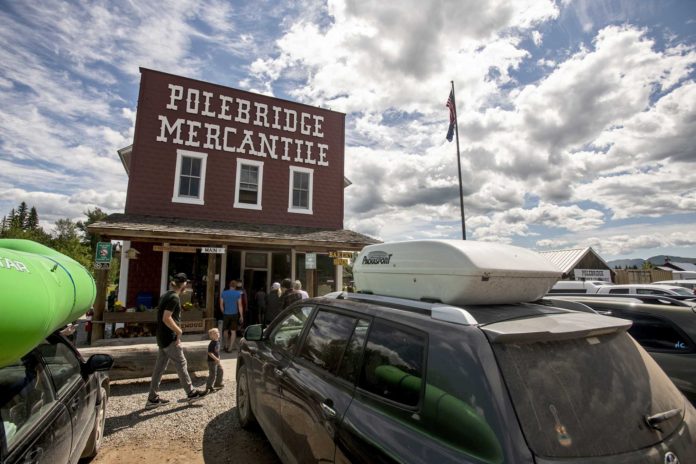-
The Polebridge Mercantile is one of two establishments at the outpost in Polebridge, Mont., on July 5, 2020. A recent study from the Institute for Tourism and Recreation at the University of Montana found that this year, Montanans deemed visitors to be slightly less polite, less patient, less environmentally responsible and less sensitive to the “Montana way of life.” Anecdotally, a Montana flyfishing guide said the COVID-19 pandemic seemed to bring out tourists who had never really experienced the outdoors before. (Ben Allan Smith/Missoulian via AP) lessThe Polebridge Mercantile is one of two establishments at the outpost in Polebridge, Mont., on July 5, 2020. A recent study from the Institute for Tourism and Recreation at the University of Montana found that … more
Photo: Ben Allan Smith, AP
Photo: Ben Allan Smith, AP
MISSOULA, Mont. (AP) — Hilary Hutcheson, a longtime flyfishing guide and flyshop owner in Columbia Falls, said she and her staff were inundated this summer with tourists who had never really experienced the outdoors before.
“A lot of not just first-time anglers, but first-time campers, first-time taking a family vacation to a national park,” she recalled. “This is anecdotal-based, but it seemed like Montana was their third choice after going to Disneyland or going to Europe. They had a big different trip planned and ‘see the USA in a Chevrolet’ wasn’t their first choice. But because of COVID that’s what they ended up doing.”
For the first time, Hutcheson and her staff had to make it a point to tell people that bear spray isn’t a repellent that you spray on your kids like insect repellent. They were also overwhelmed by people who had seen fly-fishing portrayed in movies like “A River Runs Through It” and wanted a full wader set-up.
“As opposed to whitewater fly-fishing that we do here with rafts and driftboats, they wanted exactly what they’d seen in media,” Hutcheson told the Missoulian.
The pandemic meant a flood of Americans who normally wouldn’t have ended up in Montana came here this spring, summer and fall. And based on feedback collected this summer, Montanans still have an overall favorable view of tourists and the money they bring here, but 2020 put strains on that sentiment.
A new study from the Institute for Tourism and Recreation Research at the University of Montana has found that compared to years past, Montanans deemed visitors to be slightly less polite, less patient, less environmentally responsible and less sensitive to the “Montana way of life.”
“The general trend is there’s still really positive perceptions of tourism in the state and perceptions of visitor behavior, but it’s just slightly lower than years past,” explained Carter Bermingham, a research associate at the Institute who worked on the study with Megan Schultz.
Another similar study by the Institute found that there has been a drop in Montana residents’ views of the tourism industry, with fewer believing the benefits outweigh the costs and fewer believing that Montanans’ quality of life will improve with more visitors.
The majority of Montana residents (70%) felt that the overall benefits of tourism outweigh the negative impacts, but that represents a 9 percentage point drop in agreement from 2019 and the lowest agreement level in 10 years.
“Forty-seven percent of residents agreed or strongly agreed that the quality of life for Montana residents would improve with increased tourism,” the study’s authors wrote. “This is also the lowest agreement level in a decade.”
The most significant change in attitude, they added, was seen in the responses to the statement, “In recent years, the state is becoming overcrowded because of more tourists.” For the first time in 10 years, more people agreed than disagreed with that statement, representing an increase of 18 percentage points over 2019 responses.
Still, the report showed the majority of residents view tourism generally favorably, just not as much as before.
For the most recent study, the Institute hired people to hand out surveys to Montana residents and collected responses from 1,516 people around the state this past summer.
Residents were asked how they would assess the general or overall behavior of visitors to Montana for the summer of 2020 and then asked them how they would answer those questions for years past. On a scale of 1 to 10, with one serving as the most negative response (rude) and 10 serving as the most positive (polite), residents were given a series of behaviors in which to comment. The majority of respondents found visitors during the summer of 2020 to be fairly polite, with 70% selecting either a six or higher for a mean score of 6.71.
But the mean score those respondents gave for tourists when they were asked about past years was 7.17.
Montana residents also scored tourists as less patient and less sensitive to the “Montana way of life.” There was also a discrepancy between 2020 and years past, in the eyes of Montana residents, on tourists’ environmental responsibility. They gave visitors a mean score of 5.44 this year but had a 5.57 in earlier years.
Hutcheson, the fly-fishing guide and owner of Lary’s Fly & Supply in Columbia Falls, said at first it was “shocking” to see how many people who had no idea what they were doing coming to Montana to recreate. But, she and her staff were able to take those encounters and turn them into “teachable moments.”
“We want to first help them understand how to make Montana’s outdoors a safe place and a welcoming place for all,” she said. “There’s a lot you can do there before you go in like a wrecking ball. There’s a lot to teach about understanding the ecosystem and the risks and how humans have a role here.”
Outdoor shop workers are on the front lines of teaching newcomers about best practices in the outdoors such as “leave no trace” ethics, bear awareness, human waste disposal, navigation and proper catch-and-release fishing techniques. Hutcheson said there’s also an opportunity to teach them about natural resource extraction, climate change, stream degradation and all kinds of other environmental topics they may have never considered before. That way, they can take that knowledge back to Georgia and New York and Wisconsin and other places and work in better practices in their own communities.
“For all of us outdoor educators and stewards, we have this opportunity to expose and entire new group of people to becoming stewards as opposed to being frustrated that they didn’t know how to conduct themselves out there,” she said. “We wanted to be sure that when they leave, Glacier is still picture-perfect and pristine and they can go back to their home waters and be champions of change.”
Bermingham said they’d heard reports from park rangers about a rise in people who had never really hiked or spent time in the outdoors before, showing up in droves. He said the Institute will be going through its data and will release a report in 2021 that should clear up whether there was a spike in inexperienced outdoor enthusiasts in Montana in 2020.
There is plenty of anecdotal evidence to suggest that many people in Montana this summer hadn’t done much camping, hiking or boating before.
Loren Flynn, the Montana Fish, Wildlife and Parks regional state park manager for the Missoula region, told the Missoulian in November that parks all over the state saw record visitation.
“We saw a lot of visitors who were not accustomed to being outdoors, not used to camping and hiking,” he said. “They started doing that because that’s what was available. The question is how many of these people are converts. For how many people is this going to be a part of their regular life? Time will tell. There will probably be new habits in the post-COVID world. We don’t expect to go right back to 2019 numbers. We anticipate elevated visitation next year.”
Credit: Source link






























